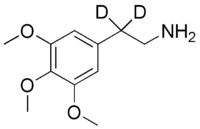Beta-D
 | |
 | |
| Names | |
|---|---|
| IUPAC name
2-(3,4,5-Trimethoxyphenyl)(2,2-2H2)ethanamine | |
| Other names
3,4,5-Trimethoxy-beta-dideuterophenethylamine 3,4,5-Trimethoxy-1-ethyl-(beta-dideutero)amine | |
| Identifiers | |
| 1020518-89-1changed | |
| 3D model (Jmol) | Interactive image |
| ChemSpider | 21106267 |
| |
| |
| Properties | |
| C11H15D2NO3 | |
| Molar mass | 213.27 g/mol |
| Except where otherwise noted, data are given for materials in their standard state (at 25 °C [77 °F], 100 kPa). | |
| | |
| Infobox references | |
Beta-D, or 3,4,5-trimethoxy-beta-dideuterophenethylamine, is a lesser-known psychedelic drug. It is one of the few phenethylamines used as a recreational drug that is enriched in deuterium. Beta-D can be prepared as a sulfate salt or as a hydrochloride salt. It is the beta-dideutero analog of mescaline. Beta-D was first synthesized by Alexander Shulgin. In his book PiHKAL (Phenethylamines i Have Known And Loved), the dosage is listed as approximately 200-400 mg for the sulfate salt, and 178-356 mg for the hydrochloride salt. Its effects last for 12 hours. Beta-D has a very rapid onset. It produces an increased appreciation of music and a strong connection with God.[1] Very little data exists about the pharmacological properties, metabolism, and toxicity of Beta-D.
References
- ↑ Shulgin, Alexander; Ann Shulgin (September 1991). PiHKAL: A Chemical Love Story. Berkeley, California: Transform Press. ISBN 0-9630096-0-5. OCLC 25627628.
See also
- 4-D (psychedelic), another deuterated analog of mescaline